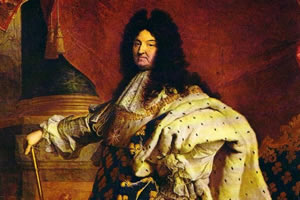During the Middle Ages, political ordering was supported by the ideological monopoly exercised by the Christian Church. The essentially religious mentality helped society to be seen as an extension of the Holy Trinity. The serfs had the function of working the land. The noble class enjoyed the wealth produced by the serfs and was dedicated to protecting their lands. At the top of this hierarchy was the Church, whose goal was to guarantee the spiritual salvation of all.
This ideological justification, in most cases, was reaffirmed through images and sumptuous constructions where the power of institutions could be visually perceived. It is important to remember that the mastery of letters was limited to clerics and a small portion of the population that enjoyed the opportunity to learn other languages or get in contact with different construction.
The end of the medieval period brought with it another power structure now not only administered by the clerics. From then onwards, the monarchs were of fundamental importance for the newly instituted power to meet the demands of new social groups that appeared along with the urban and commercial renaissance experienced over the centuries XII and XV. However, meeting the needs of the bourgeoisie or winning over peasant revolts are not enough to legitimize this new authority.
The mythical symbols and ideas that presented themselves in the medieval imagination also had space in the midst of the Modern National States. The king, covered in his garments full of details and colors, distinguished himself from his subjects by his appearance. In addition, a king used to wear gold-coated ornaments and carry sacred relics in his hands. Every theory of the divine right of kings was transfigured through gestures and objects of striking distinction.
In France, this unique aura was reaffirmed through different rituals. When a new monarch came to power, Reims Cathedral was prepared so that the clerics had to recognize God's new chosen one. The clerical blessing, more than proving any kind of agreement or subordination between State and Church, it indicated the consummation of a magical event where the people saw a new predestined occupying a place of character sacred.
Thus, more than an individual occupying a political office, the king was seen as an instrument endowed with irrevocable virtues such as justice, order, prosperity, victory and strength. According to some historians, Jesus' passion for his faithful was transposed into a new relationship where the monarch would be selfless to his subjects gathered within the limits of that Nation. Thus, as pointed out in the Bible, the king would be the head of a “house” composed of a multitude of people who would represent the other parts of a harmonious body.
This sacred dimension was built during the centuries of the Modern Age and brought with it the remnants of various values from the medieval world. It was only from the 18th century onwards, with the explosion of Enlightenment rationalism, that we noticed the construction of an argument against the veneration dedicated to the king. Among the most significant historical experiences that promoted this rupture, we give special attention to the French Revolution.
Do not stop now... There's more after the advertising ;)
By Rainer Sousa
Graduated in History
Would you like to reference this text in a school or academic work? Look:
SOUSA, Rainer Gonçalves. "The Mythification of the Monarchy"; Brazil School. Available in: https://brasilescola.uol.com.br/historiag/a-mitificacao-monarquia.htm. Accessed on June 27, 2021.
General history

Absolutism, Absolutist States, National Monarchies, Absolutist Monarchies, Modern Age, Renaissance, bourgeoisie mercantile, feudal barriers, national symbols, unification of territories, Hundred Years War, War of Reconquest, theory absolute


